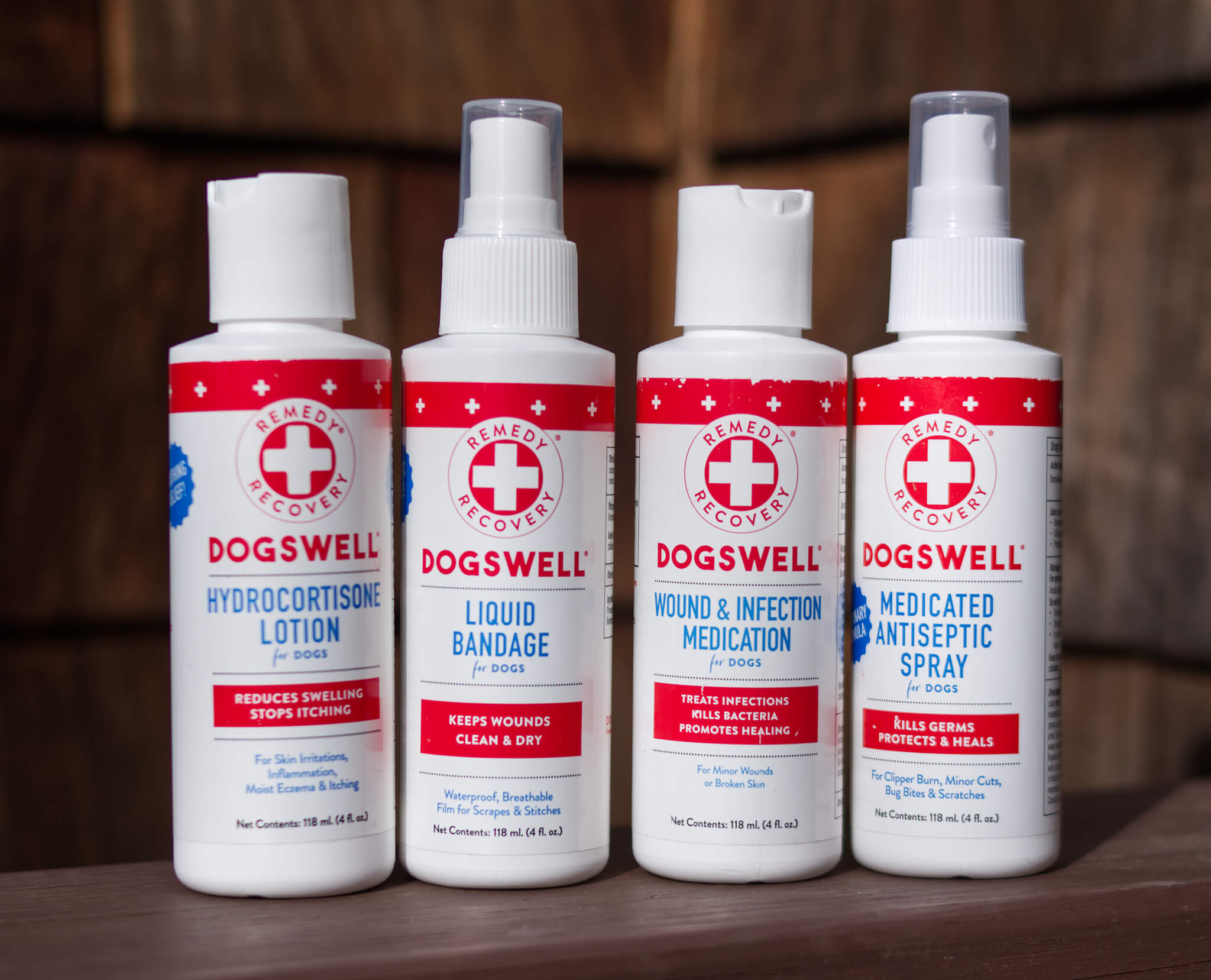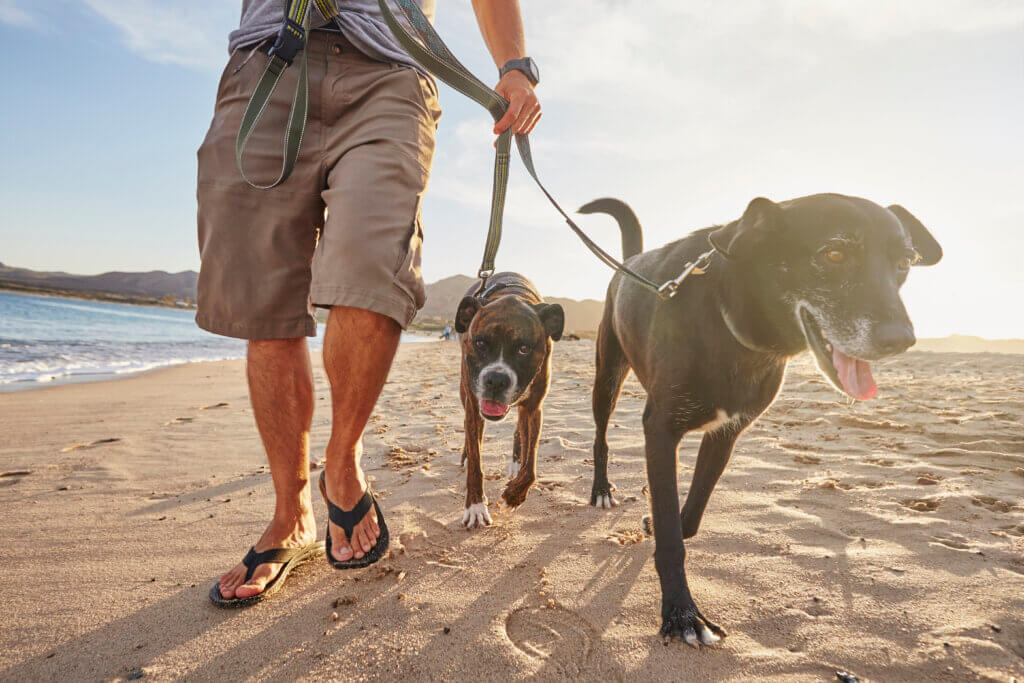Accidents can happen any time, but summer is the peak season. With more outdoor exercise, playing, and adventures, there are more chances for injuries. But don’t let it stop you from enjoying the sunshine with your best friend. Be prepared with basic first aid supplies and knowledge about what to do if and when minor injuries occur.
One of the most important things you can do to be prepared is to assemble a first aid kit for your dog. Human ointments, creams, and medications are not formulated for dogs and can be harmful to their bodies. Dogs need first aid supplies that are made for them.
The American Veterinary Medical Association recommends that all pet owners keep basic first aid supplies for pets in their homes. At Dogswell, we strongly agree and believe that first aid can save dogs’ lives – which is why we make it easy for pet parents to access first aid supplies for their dogs. For tips on how to start your dog’s first aid kit, see our blog post.
Common Dog Injuries at Home
Like humans, most dog injuries happen at home. It’s simply where we spend the most time. Here are a few of the most common dog injuries and how to treat them.
Minor Cuts – A minor cut is a shallow cut or scrape that produces light bleeding. They are fairly common and can often be treated at home. (If your dog’s cut is long, deep, and will not stop bleeding, see a veterinarian right away). Dogs can accidentally step on or get too close to a sharp object. When this happens, first clean the cut with soap and water if possible, and apply Dogswell® Remedy & Recovery® Medicated Antiseptic Spray. Then, add a pinch of Styptic Powder to the bleeding area and apply moderate pressure. Once the bleeding stops, rub on Wound & Infection Medication to help kill bacteria and promote healing. Finally, cover the wound with Liquid Bandage for dogs to help soothe and protect the wound, keeping it clean and dry.
Bite Wound – If your dog’s wound is the result of a bite from another dog, cat or other animal, call your veterinarian. Mouths contain a lot of bacteria, so bite wounds often get infected. Your veterinarian can also help determine if any other treatment is necessary.
Poison – Cats aren’t the only curious pets. Dogs get into things they shouldn’t all the time, especially puppies. Be very careful to keep toxins away from your dog, including household cleaners, human medications, fertilizers, pesticides, antifreeze, toxic foods (like grapes, onions, and chocolate) and toxic plants (like lilies). If your dog ingests any of these toxicities, call the ASPCA’s Animal Poison Control Center at 1-888-426-4435, and see an emergency veterinarian immediately.
Insect Sting or Bite – Mosquitos, fleas, and other insects bite dogs just like they bite humans. If you notice that your dog has a red, swollen bite mark that is causing pain and/or itchiness, apply Dogswell® Remedy & Recovery® Medicated Hot Spot Spray for dogs or Dogswell Remedy & Recovery Hydrocortisone Lotion for dogs. If your dog is stung by a bee or a wasp, carefully remove the stinger with tweezers, then apply ice and hydrocortisone lotion to relieve pain and swelling. Observe your dog carefully for the next hour. If your dog starts to break out in hives, has swelling in the face, or difficulty breathing, they are having an allergic reaction and need emergency veterinary help right away.

Keep in mind: When dogs get hurt, they have certain natural reflexes. If they’re in pain, they may reflexively try to bite you while you’re treating their wound. It’s a good idea to keep a muzzle with your first aid kit for that reason. Dogs also lick and bite at wounds. An Elizabethan collar, also known as the “cone of shame,” is another great item to keep on hand, as it prevents dogs from reaching the wound, expediting the healing process.
Preparing for a Summer Outdoor Adventure with Your Dog
If you’re taking your dog on a fun outdoor activity, like hiking, canoeing, or camping, it’s important to think about your dog’s safety as you plan your outing.
Before you go:
- Be sure to give your dog their monthly heartworm, flea and tick preventive medicines.
- Make sure your dog is microchipped and wearing a collar with your current home address and phone number, in case they get lost.
- Choose an activity that suits their age and fitness level.
- Research and select a route or camp site with plenty of shade to keep your dog cool.
- Program the phone number for your veterinarian into your phone (if you haven’t already), as well as the number for a nearby emergency veterinary hospital.
Items to bring with you:
- A sturdy, non-retractable leash
- Plastic bags to pick up their waste
- Plenty of water and a bowl
- High protein dog treats
- Dog food and any daily medications if spending the night
- Flashlight
- Emergency blanket
- A first aid kit, including a tick removal tool
- A dog life vest if you’ll be in deep water
When you get home:
- Brush your dog and check for ticks, bites, or other injuries.
- Bathe your dog if needed.
- Allow them to get plenty of rest and recovery time.
Keep Your Dog Cool
We can’t talk summer safety without mentioning the heat. Dogs can get overheated very quickly. If your dog has long, thick fur, consider giving them a summer haircut. Avoid going too short, however. Without enough insulating fur, shaving them down can actually make them more susceptible to overheating and sunburn. Always keep fresh water available to your dog both inside and outside in the shade. Take them for walks at cooler times of the day, like first thing in the morning. And, never leave your dog in a parked car. Not even for five minutes.
As the sun starts to heat things up, it’s natural to want to get outside. This summer, plan your fun with safety in mind and be prepared with first aid supplies for your dog. As always, when in doubt, call your veterinarian.

